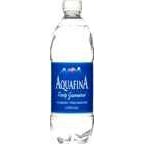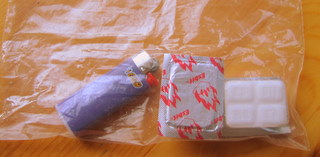 I love mornings. I’m usually awake by 5am, and love getting an early start but I also enjoy drinking hot beverages and appreciating the morning. This is my usual morning routine, on the trail.
I love mornings. I’m usually awake by 5am, and love getting an early start but I also enjoy drinking hot beverages and appreciating the morning. This is my usual morning routine, on the trail.
From the comfort of my sleeping bag, I reach out of my tent, start my stove and heat up water to make a 16 oz nalgene bottle full of instant coffee. I put the bottle in my bag to warm me up while I eat my breakfast. Breakfast is usually cereal, nuts and powder milk mixed with water.
full of instant coffee. I put the bottle in my bag to warm me up while I eat my breakfast. Breakfast is usually cereal, nuts and powder milk mixed with water.
After I eat, I drink my coffee and enjoy the morning. Then I heat more water and make green tea in my nalgene bottle. While I drink that I look over the guide book pages for the day. Then using the same tea bag I make another nalgene bottle full of tea. When I finish that, I wash my face with the warm tea bag, and stow it in an outside mesh pocket of my pack until it is dry and can go in my ziplock garbage sack.
Then I leave the comfort of my bag, pack up (I can pack up in 2-4 minutes), and go. This way I start the day hydrated and with little or no water that I have to carry.
Note: If the days are blistering hot, the cool mornings can’t be wasted on sleeping, beverages, or breakfast. On those days, I pack up, grab a meal bar, and hike on.
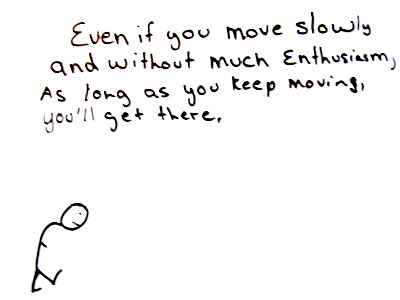
 To make this lightweight backpacking brush, I bought the smallest hair brush I could find and ripped the little rubber head out of it. It weighs .45 ounce or 12 grams.
To make this lightweight backpacking brush, I bought the smallest hair brush I could find and ripped the little rubber head out of it. It weighs .45 ounce or 12 grams.
 1.If you carry hiking poles, collapse them and put them away. Make sure they won’t scratch or poke a hole in the car’s upholstery.
1.If you carry hiking poles, collapse them and put them away. Make sure they won’t scratch or poke a hole in the car’s upholstery.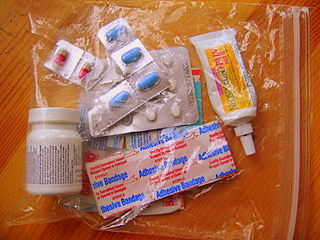 This is what is what I carry when backpacking:
This is what is what I carry when backpacking: This is my wash kit: a
This is my wash kit: a 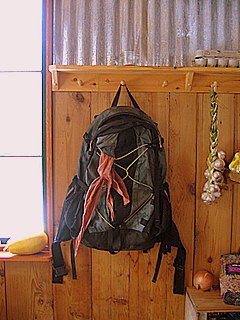 Because half of a bandana cut diagonally will do every thing a whole bandana does, I cut my bandana in two. I, however, end up bringing both halfs because I have incompatible uses for them. I cut or make a button hole in one end so that I can loop it to the outside of my pack, or around my neck. This system works a lot better than tying it on. I haven’t lost a bandana since getting the
Because half of a bandana cut diagonally will do every thing a whole bandana does, I cut my bandana in two. I, however, end up bringing both halfs because I have incompatible uses for them. I cut or make a button hole in one end so that I can loop it to the outside of my pack, or around my neck. This system works a lot better than tying it on. I haven’t lost a bandana since getting the button hole put in it. If you don’t hem it, it will get pretty ratty looking.
button hole put in it. If you don’t hem it, it will get pretty ratty looking.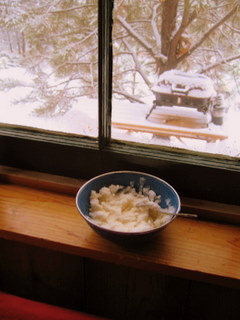 A lot of new snow fell today. I scooped some up in a bowl and poured some canned milk, vanilla syrup and some caramel syrup on it and mixed it all up. It tasted a little like ice cream. My favorite snow topping is lemon juice and sugar, but I don’t have any more lemon juice. For awhile I was putting instant ice tea mix on the snow. I liked that but I’m out of that too. When on the trail I have flavored my snow with lemonade mix or Jello mix (both of which make excellent hot beverages as well).
A lot of new snow fell today. I scooped some up in a bowl and poured some canned milk, vanilla syrup and some caramel syrup on it and mixed it all up. It tasted a little like ice cream. My favorite snow topping is lemon juice and sugar, but I don’t have any more lemon juice. For awhile I was putting instant ice tea mix on the snow. I liked that but I’m out of that too. When on the trail I have flavored my snow with lemonade mix or Jello mix (both of which make excellent hot beverages as well).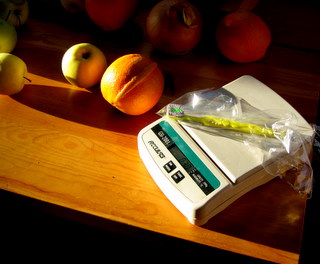 For working on getting my pack weight down, I weigh everything that goes in my pack, that doesn’t get eaten, on this
For working on getting my pack weight down, I weigh everything that goes in my pack, that doesn’t get eaten, on this 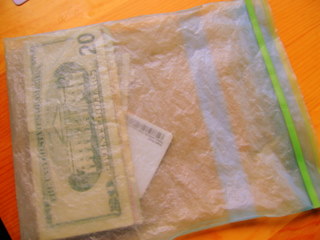 For a wallet, I use a plastic ziplock baggie. I convert all my coins into food, before leaving town. I carry in it: cash, debit card, driver’s license and a data card. I make a data card like a business card on the computer, or just write everything down on piece of paper, laminating it is a plus. Included on my data card are my phone card number and pin, phone numbers of people I want to call, and phone numbers of outfitters that I might have to order replacement gear from, and my bank’s phone number.
For a wallet, I use a plastic ziplock baggie. I convert all my coins into food, before leaving town. I carry in it: cash, debit card, driver’s license and a data card. I make a data card like a business card on the computer, or just write everything down on piece of paper, laminating it is a plus. Included on my data card are my phone card number and pin, phone numbers of people I want to call, and phone numbers of outfitters that I might have to order replacement gear from, and my bank’s phone number.
